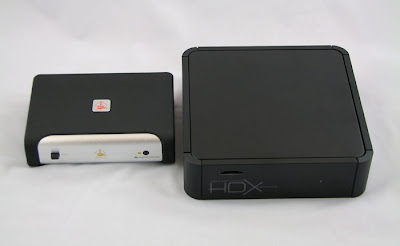This is the 6th part of our HDX 1000 review. We are going to compare HDX 1000 with its previous generation: HDX 900 and one of its competitors, iStarHD HDMI 1.3 Mini NMT player.
HDX 1000 vs. HDX 900
Function-wise, the HDX 1000 works almost identical as the HDX 900. The major change on the HDX 1000 is the adoption of the HDMI 1.3 standard. (According to Wikipedia: the single-link bandwidth to 340MHz (10.2 Gbit/s) is the HDMI 1.3 version). It will supposedly enhance the performance of the HDX 1000. However, I have not learned a quantitative way to test the results yet. I can only say, judging from my eyes, the content playback is a little smoother on the HDX 1000. But, again, the “smoother performance” can be no more than a illusion generated by my brain after learning the difference between HDMI 1.1 and HDMI 1.3 on Wikipedia.

The most significant change to the HDX 1000 is on its design and the output interface. A picture with HDX 1000 and HDX 900 placed side-by-side is present above. The right one is an HDX 1000.
- You can see the size of the case has shrunk. The trim down of the metal used on the case has lowerered the weight of the machine itself from 3 lbs. to 2.2 lbs. This will help users to save on the shipping costs.
- The sharp corner of the HDX 900 case has been redesigned to an oval shape. Compared to the HDX 900’s industrial equipment appearance, the HDX 1000 now looks more like a consumer electronics product of which you would have little objection to placing on your home entertainment rack.
- The VGA display output on the HDX 900 has been removed and replaced by a coaxial and component output. Now you don’t need to have a HDTV to use the HDX 1000. It can work with an analog TV, too. I guess HD Digitech has listened to customers’ suggestions.
- The SATA port (data only) presented on the HDX 900’s back panel has been removed on the HDX 1000. The SATA connector without the power portion can be a headache to users because they need to go find a power source to power the HDD they want to install on the HDX 900. The SATA port has been moved inside the case on the HDX 1000. It is a complete connector with data and power ports provided. It is also safer to have the HDD placed inside the case, thus reducing the chance of having the HDD electronics components exposed to users.
- The power hard-switch on the HDX 1000 has been moved to the back panel. (I like it on the front panel better, for easy-access purposes.)
- With the HDX 900, there is a chance of having the VGA connector head / SATA connector head / HDMI connector head interfere with each other. In other words, you might need to unplug one of the connectors in order to have another connector plugged in. This is not an issue any more in HDX 1000.
- A card reader is installed on the front panel of the HDX 1000. Please see the below picture.

Overall, HD Digitech includes several design changes to the HDX 1000, which have been requested by real media streamer users. It indicates that they have a good attitude of listening to customers and trying to provide what they need. I certainly appreciate this attitude.
HDX 1000 vs. iStarHD HDMI 1.3 Mini NMT player
HDX 1000 and iStarHD HDMI 1.3 mini NMT player are based on the same media receiver solution: Sigma 3865 chipset + Syabas NMT player. Hence, they perform very similar functions. The differences are in the design, cooling and output ports selection.
- In the picture below you can see the box size comparison between the HDX 1000 and the iStarHD 1.3. The latter is almost half in size.

- The most significant difference between the two units is the case material. The HDX 1000 is made of aluminum and the iStarHD 1.3 is made of plastic. Thus, the iStarHD 1.3 is a lighter product.
- On the other hand, the aluminum case material enables the HDX 1000 have a better heat transfer characteristic. That is why the iStarHD 1.3 needs to install a Fan inside the box, but the HDX 1000 does not. This allows the HDX 1000 to perform with less acoustic noise. In theory, the cooler operating temperature will help components to achieve a longer life. However, this needs to be verified with the HDX 1000.
- There is a card reader on the HDX 1000, but not on the iStarHD 1.3.
- The SATA HDD connector is located outside of the iStarHD 1.3 case. Therefore, the “internal HDD” needs to be installed outside of the iStarHD 1.3 box. With the HDX 1000, the “internal HDD” needs to be installed inside its box.

- HDX 1000 provides more options regarding output interface.
It is a classic trade-off situation. The iStarHD 1.3 offers a cheaper solution while the HDX 1000 provides more value (card reader, aluminum case, more output options…). You can make your own decision to see if the price difference for the HDX 1000 is really worth the money.
More…
At the time this review was written, I had not yet received my Popcornhour A-110. After I receive my machine, I’ll add a HDX 1000 vs. Popcornhour A-110 section to make this review more complete.
Read the 7th part of the HDX 1000 Review - Known Issues, Workaround and Conclusions
Go to the HDX 1000 Product Page at AmperorDirect.com




1 comment:
Post a Comment